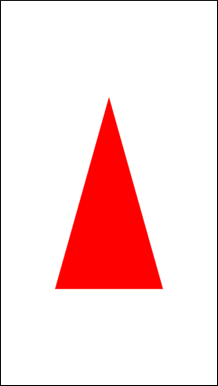GLView
GLView is a common component that is used to render the view with OpenGL® ES.
Figure: GLView rendering a triangle with OpenGL® ES

Add namespace
To use GLView, include Tizen.NUI.Components and OpenTK.Graphics namespace in your application. You should refer to the OpenTK usage:
C#
Copy
using Tizen.NUI;
using Tizen.NUI.Components;
using OpenTK.Graphics.ES30;
This guide uses OpenTK.Tizen.
Create a GLView
To create a GLView, follow these steps:
-
Put ColorFormat in the GLView constructor:
C#CopyglView = new GLView(GLView.ColorFormat.RGBA8888); -
Set the rendering mode. There are Continuous and OnDemand modes. When you set OnDemand, you have to call RenderOnce() method to invoke the GLRenderFrame callback in the render thread:
C#CopyglView.RenderingMode = Tizen.NUI.GLRenderingMode.Continuous; -
Set graphics configuration. You have to set surface configuration and GLES version:
C#CopyglView.SetGraphicsConfig(true, true, 0, Tizen.NUI.GLESVersion.Version30); -
Register GLInit, GLRender, GLTerminate callbacks:
C#CopyglView.RegisterGLCallbacks(this.InitializeGL, this.RenderFrameGL, this.Terminate.GL); -
Set resize callback. You can get the resized size of the GLView on the render thread:
C#CopyglView.SetResizeCallback(this.ResizeCallback);
Callbacks
Callbacks are invoked on the GLView render thread:
C#
Copy
public delegate void GLInitializeDelegate();
public delegate int GLRenderFrameDelegate();
public delegate void GLTerminateDelegate();
public delegate void ViewResizeDelegate(int w, int h);
These snippets just clear the buffer to white.
Initialize callback
Initialize callback by using the following code:
C#
Copy
public void InitializeGL()
{
//Set the ClearColor to white
GL.ClearColor(1.0f, 1.0f, 1.0f, 1.0f);
}
Render callback
Render callback by using the following code:
C#
Copy
public int RenderFrameGL()
{
//Set the viewport size
GL.Viewport(0, 0, width, height);
//Clear the buffer with the ClearColor.
GL.Clear(ClearBufferMask.ColorBufferBit);
//When returning not 0, the eglSwapBuffers is called.
return 1;
}
Terminate callback
Terminate callback with the following code:
C#
Copy
public void TerminateGL()
{
// Destroy GL resources
}
Resize callback
Resize callback with the following code:
C#
Copy
public void ResizeCallback(int w, int h)
{
width = w;
height = h;
}
GLView properties
The following table defines the GLView class control properties:
Table: ImageView control properties
| Property | Type | Description |
|---|---|---|
RenderingMode |
GLRenderingMode |
The rendering mode of GLView |
Triangle example
The following code shows how a triangle is rendered using GLView with OpenGL® ES:
C#
Copy
using System;
using Tizen.NUI;
using Tizen.NUI.BaseComponents;
using OpenTK.Graphics.ES30;
namespace GLViewSample
{
class Program : NUIApplication
{
private int glProgram;
private int width;
private int height;
private float[] vVertices;
private GLView glView;
protected override void OnCreate()
{
base.OnCreate();
Initialize();
}
void Initialize()
{
glView = new GLView(GLView.ColorFormat.RGBA8888);
glView.WidthResizePolicy = ResizePolicyType.FillToParent;
glView.HeightResizePolicy = ResizePolicyType.FillToParent;
glView.SetGraphicsConfig(true, true, 0, GLESVersion.Version30);
glView.RenderingMode = GLRenderingMode.Continuous;
glView.RegisterGLCallbacks(this.InitializeGL, this.RenderFrameGL, this.TerminateGL);
glView.SetResizeCallback(this.ResizeCallback);
Window.Instance.KeyEvent += OnKeyEvent;
Window.Instance.BackgroundColor = Color.White;
Window.Instance.GetDefaultLayer().Add(glView);
}
public void ResizeCallback(int w, int h)
{
width = w;
height = h;
}
int LoadShader(ShaderType type, string shaderSrc)
{
int shader;
// Create the shader object
shader = GL.CreateShader(type);
if (shader == 0)
{
return 0;
}
// Load the shader source
GL.ShaderSource(shader, 1, new string[] { shaderSrc }, (int[])null);
// Comoppile the shader
GL.CompileShader(shader);
// Check the compile status
GL.GetShader(shader, ShaderParameter.CompileStatus, out int compiled);
if (compiled == 0)
{
int length = 0;
GL.GetShader(shader, ShaderParameter.InfoLogLength, out length);
if (length > 0)
{
GL.GetShaderInfoLog(shader, length, out length, out string log);
}
GL.DeleteShader(shader);
throw new InvalidOperationException("Unable to compile shader of type : " + type.ToString());
}
return shader;
}
public void InitializeGL()
{
//Load the shaders and get a linked program object
string vShaderStr =
"#version 300 es \n" +
"layout(location = 0) in vec4 vPosition; \n" +
"void main() \n" +
"{ \n" +
" gl_Position = vPosition; \n" +
"} \n";
string fShaderStr =
"#version 300 es \n" +
"precision mediump float; \n" +
"out vec4 fragColor; \n" +
"void main() \n" +
"{ \n" +
" fragColor = vec4 ( 1.0, 0.0, 0.0, 1.0 );\n" +
"} \n";
int vertexShader;
int fragmentShader;
int programObject;
// Load the vertex/fragment shaders
vertexShader = LoadShader(ShaderType.VertexShader, vShaderStr);
fragmentShader = LoadShader(ShaderType.FragmentShader, fShaderStr);
// Create the program object
programObject = GL.CreateProgram();
if (programObject == 0)
{
return;
}
GL.AttachShader(programObject, vertexShader);
GL.AttachShader(programObject, fragmentShader);
//Link the program
GL.LinkProgram(programObject);
// Check the link status
int linkStatus;
GL.GetProgram(programObject, GetProgramParameterName.LinkStatus, out linkStatus);
if (linkStatus == 0)
{
int infoLogLength;
GL.GetProgram(programObject, GetProgramParameterName.InfoLogLength, out infoLogLength);
if (infoLogLength > 0)
{
String infoLog;
GL.GetProgramInfoLog(programObject, infoLogLength, out infoLogLength, out infoLog);
Tizen.Log.Debug("GLViewSsample", "Couldn't link program: " + infoLog.ToString());
}
GL.DeleteProgram(programObject);
return;
}
// Store the program obejct
glProgram = programObject;
vVertices = new float[] { 0.0f, 0.5f, 0.0f, -0.5f, -0.5f, 0.0f, 0.5f, -0.5f, 0.0f };
GL.VertexAttribPointer(0, 3, VertexAttribPointerType.Float, false, 0, vVertices);
GL.EnableVertexAttribArray(0);
}
public int RenderFrameGL()
{
Tizen.Log.Debug("GLViewSample", "RenderFrameGL");
GL.ClearColor(1.0f, 1.0f, 1.0f, 1.0f);
// Set the viewport
GL.Viewport(0, 0, width, height);
// Clear the color buffer
GL.Clear(ClearBufferMask.ColorBufferBit);
// Use the program object
GL.UseProgram(glProgram);
// Load the vertex data
GL.DrawArrays(PrimitiveType.Triangles, 0, 3);
return 1;
}
public void TerminateGL()
{
GL.DeleteProgram(glProgram);
}
public void OnKeyEvent(object sender, Window.KeyEventArgs e)
{
if (e.Key.KeyPressedName == "XF86Back" || e.Key.KeyPressedName == "Escape")
{
Exit();
}
}
static void Main(string[] args)
{
var app = new Program();
app.Run(args);
}
}
}
Related information
- Dependencies
- Tizen 7.0 and Higher